Trace Cd2+ Ions Detection on the Flower-Like Ag@CuO Substrate
Abstract
:1. Introduction
2. Materials and Methods
2.1. Reagents
2.2. Sample Preparation
2.3. Sample Description
2.4. SERS Measurement
3. Results and Discussion
3.1. Structures Characterization and Elementary Composition
3.2. SERS Performance
3.2.1. SERS Determination of R6G
3.2.2. SERS Determination of Cd2+ Ions
3.3. Mechanism
4. Conclusions
Supplementary Materials
Author Contributions
Funding
Conflicts of Interest
References
- Chen, Y.; Chen, Z.P.; Long, S.Y.; Yu, R.Q. Generalized ratiometric indicator based surface-enhanced Raman spectroscopy for the detection of Cd2+ in environmental water samples. Anal. Chem. 2014, 86, 12236–12242. [Google Scholar] [CrossRef]
- Bhanjana, G.; Dilbaghi, N.; Singhal, N.K.; Kim, K.H.; Kumar, S. Copper oxide nanoblades as novel adsorbent material for cadmium removal. Ceram. Int. 2017, 43, 6075–6081. [Google Scholar] [CrossRef]
- Wang, J.H.; Liu, Y.M.; Chao, J.B.; Wang, H.; Wang, Y.; Shuang, S. A simple but efficient fluorescent sensor for ratiometric sensing of Cd2+ and bio-imaging studies. Sens. Actuators B 2020, 303, 127216. [Google Scholar] [CrossRef]
- World Health Organization. Guidelines for Drinking-Water Quality, 3rd ed.; World Health Organization: Geneva, Switzerland, 2008; Volume 1, pp. 317–319. [Google Scholar]
- National Toxicology Program. Second Annual Report on Carcinogens; U.S. Department of Health and Human Services: Washington, DC, USA, 1981; pp. 73–80.
- Si, Y.; Liu, J.; Chen, Y.; Miao, X.; Ye, F.; Liu, Z.; Li, J. rGO/AuNPs/tetraphenylporphyrin nanoconjugate-based electrochemical sensor for highly sensitive detection of cadmium ions. Anal. Methods 2018, 10, 3631–3636. [Google Scholar] [CrossRef]
- Yuan, X.; Yang, L.; Liu, S.; Yang, H.; Tang, Y.; Huang, K.; Zhang, M. An effective analytical system based on an ultraviolet atomizer for trace cadmium determination using atomic fluorescence spectrometry. Anal. Methods 2018, 10, 4821–4826. [Google Scholar] [CrossRef]
- Anthemidis, A.N.; Karapatouchas, C.P.P. Flow injection on-line hydrophobic sorbent extraction for flame atomic absorption spectrometric determination of cadmium in water samples. Microchim. Acta 2008, 160, 455–460. [Google Scholar] [CrossRef]
- Zhang, N.; Hu, B. Cadmium (II) imprinted 3-mercaptopropyltrimethoxysilane coated stir bar for selective extraction of trace cadmium from environmental water samples followed by inductively coupled plasma mass spectrometry detection. Anal. Chim. Acta 2012, 723, 54–60. [Google Scholar] [CrossRef]
- Raman, C.V.; Krishnan, K.S. A new type of secondary radiation. Nature 1928, 121, 501–502. [Google Scholar] [CrossRef]
- Tang, H.; Zhu, C.; Meng, G.; Wu, N. Surface-enhanced Raman scattering sensors for food safety and environmental monitoring. J. Electrochem. Soc. 2018, 165, B3098–B3118. [Google Scholar] [CrossRef]
- Fleischmann, M.; Hendra, P.; McQuillan, A. Raman spectra of pyridine adsorbed at a silver electrode. Chem. Phys. Lett. 1974, 26, 163–166. [Google Scholar] [CrossRef]
- Jeanmaire, D.L.; Van Duyne, R.P. Surface Raman spectroelectrochemistry: Part, I. Heterocyclic, aromatic, and aliphatic amines adsorbed on the anodized silver electrode. J. Electroanal. Chem. 1977, 84, 1–20. [Google Scholar] [CrossRef]
- Ding, S.Y.; Yi, J.; Li, J.F.; Ren, B.; Wu, D.Y.; Panneerselvam, R.; Tian, Z.Q. Nanostructure-based plasmon-enhanced Raman spectroscopy for surface analysis of materials. Nat. Rev. Mater. 2016, 1, 1–16. [Google Scholar] [CrossRef]
- Tieu, D.T.; Trang, T.N.Q.; Thu, V.T.H. Assembly engineering of Ag@ZnO hierarchical nanorod arrays as a pathway for highly reproducible surface-enhanced Raman spectroscopy applications. J. Am. Chem. Soc. 2019, 808, 151735. [Google Scholar] [CrossRef]
- Sheng, S.; Ren, Y.; Yang, S.; Wang, Q.; Liu, Y. Remarkable SERS Detection by Hybrid Cu2O/Ag Nanospheres. ACS Omega 2020, 5, 17703–17714. [Google Scholar] [CrossRef] [PubMed]
- Jayram, N.D.; Aishwarya, D.; Sonia, S.; Mangalaraj, D.; Kumar, P.S.; Rao, G.M. Analysis on superhydrophobic silver decorated copper oxide nanostructured thin films for SERS studies. J. Colloid Interface Sci. 2016, 477, 209–219. [Google Scholar] [CrossRef] [PubMed]
- Yu, J.; Yang, M.; Zhang, C.; Yang, S.; Sun, Q.; Liu, M.; Peng, Q.; Xu, X.; Man, B.; Lei, F. Capillarity-assistant Assembly: A Fast Preparation of 3D Pomegranate-like Ag Nanoparticle Clusters on CuO Nanowires and Its Applications in SERS. Adv. Mater. Interfaces 2018, 5, 1800672. [Google Scholar] [CrossRef]
- Ye, F.; Ju, S.; Liu, Y.; Jiang, Y.; Yuan, A. Ag-CuO Nanocomposites: Surface-Enhanced Raman Scattering Substrate and Photocatalytic Performance. Cryst. Res. Technol. 2019, 54, 1800257. [Google Scholar] [CrossRef]
- Musumeci, A.; Gosztola, D.; Schiller, T.; Dimitrijevic, N.M.; Mujica, V.; Martin, D.; Rajh, T. SERS of Semiconducting Nanoparticles (TiO2 Hybrid Composites). J. Am. Chem. Soc. 2009, 131, 6040–6041. [Google Scholar] [CrossRef] [PubMed]
- Mikac, L.; Ivanda, M.; Gotić, M.; Janicki, V.; Zorc, H.; Janči, T.; Vidaček, S. Surface-enhanced Raman spectroscopy substrate based on Ag-coated self-assembled polystyrene spheres. J. Mol. Struct. 2017, 1146, 530–535. [Google Scholar] [CrossRef]
- Zhang, K.; Yao, S.; Li, G.; Hu, Y. One-step sonoelectrochemical fabrication of gold nanoparticle/carbon nanosheet hybrids for efficient surface-enhanced Raman scattering. Nanoscale 2015, 7, 2659–2666. [Google Scholar] [CrossRef] [PubMed]
- Tian, S.; Neumann, O.; McClain, M.J.; Yang, X.; Zhou, L.; Zhang, C.; Nordlander, P.; Halas, N.J. Aluminum nanocrystals: A sustainable substrate for quantitative SERS-based DNA detection. Nano Lett. 2017, 17, 5071–5077. [Google Scholar] [CrossRef] [PubMed]
- Zhu, C.; Meng, G.; Zheng, P.; Huang, Q.; Li, Z.; Hu, X.; Wang, X.; Huang, Z.; Li, F.; Wu, N. A hierarchically ordered array of silver-nanorod bundles for surface-enhanced Raman scattering detection of phenolic pollutants. Adv. Mater. 2016, 28, 4871–4876. [Google Scholar] [CrossRef] [PubMed]
- Zheng, B.; Liu, G.; Yao, A.; Xiao, Y.; Du, J.; Guo, Y.; Xiao, D.; Hu, Q.; Choi, M.M. A sensitive AgNPs/CuO nanofibers non-enzymatic glucose sensor based on electrospinning technology. Sens. Actuators B 2014, 195, 431–438. [Google Scholar] [CrossRef]
- Xu, D.; Zhu, C.; Meng, X.; Chen, Z.; Li, Y.; Zhang, D.; Zhu, S. Design and fabrication of Ag-CuO nanoparticles on reduced graphene oxide for nonenzymatic detection of glucose. Sens. Actuators B 2018, 265, 435–442. [Google Scholar] [CrossRef]
- Li, X.; Zhu, G.; Xiao, L.; Liu, Y.; Ji, Z.; Shen, X.; Kong, L.; Shah, S.A. Loading of Ag on Fe-Co-S/N-doped carbon nanocomposite to achieve improved electrocatalytic activity for oxygen evolution reaction. J. Alloys Compd. 2019, 773, 40–49. [Google Scholar] [CrossRef]
- Yang, C.; Qing, C.; Wang, Q.; Zhang, X.; Lou, J.; Liu, Y. Synthesis of the hybrid CdS/Au flower-like nanomaterials and their SERS application. Sens. Actuators B 2020, 304, 127218. [Google Scholar] [CrossRef]
- Pristinski, D.; Tan, S.; Erol, M.; Du, H.; Sukhishvili, S. In situ SERS study of Rhodamine 6G adsorbed on individually immobilized Ag nanoparticles. J. Raman Spectrosc. 2010, 37, 762–770. [Google Scholar] [CrossRef]
- Yin, J.; Wu, T.; Song, J.; Zhang, Q.; Liu, S.; Xu, R.; Duan, H. SERS-Active Nanoparticles for Sensitive and Selective Detection of Cadmium Ion (Cd2+). Chem. Mater. 2011, 23, 4756–4764. [Google Scholar] [CrossRef]
- Thatai, S.; Khurana, P.; Prasad, S.; Kumar, D. Plasmonic detection of Cd2+ ions using surface-enhanced Raman scattering active core-shell nanocomposite. Talanta 2015, 134, 568–575. [Google Scholar] [CrossRef]
- Koussinsa, F.; Bertin, F. Raman microspectrometric study of the dissolution layer of M(NO3)2·nH2O crystals (M = Mg, Ca, Zn and Cd) in their undersaturated aqueous solutions. J. Raman Spectrosc. 1991, 22, 169–176. [Google Scholar] [CrossRef]
- James, D.W.; Carrick, M.T.; Leong, W. Raman spectrum of cadmium nitrate. Aust. J. Chem. 1978, 31, 1189–1193. [Google Scholar] [CrossRef]
- Yang, L.; Lv, J.; Sui, Y.; Fu, W.; Zhou, X.; Ma, J.; Li, Q.; Sun, M.; Mu, Y.; Chen, Y. Ag-Cu2O composite microstructures with tunable Ag contents: Synthesis and surface-enhanced (resonance) Raman scattering (SE(R)RS) properties. RSC Adv. 2014, 4, 17249–17254. [Google Scholar] [CrossRef]
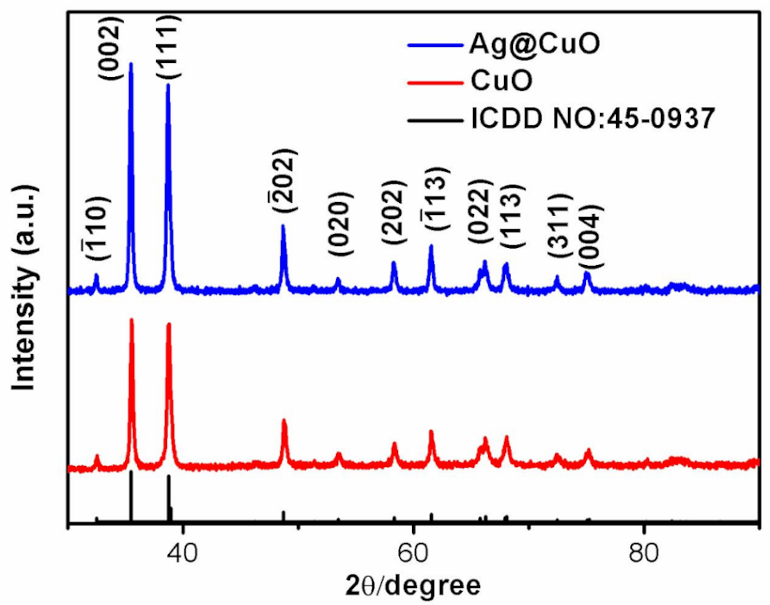
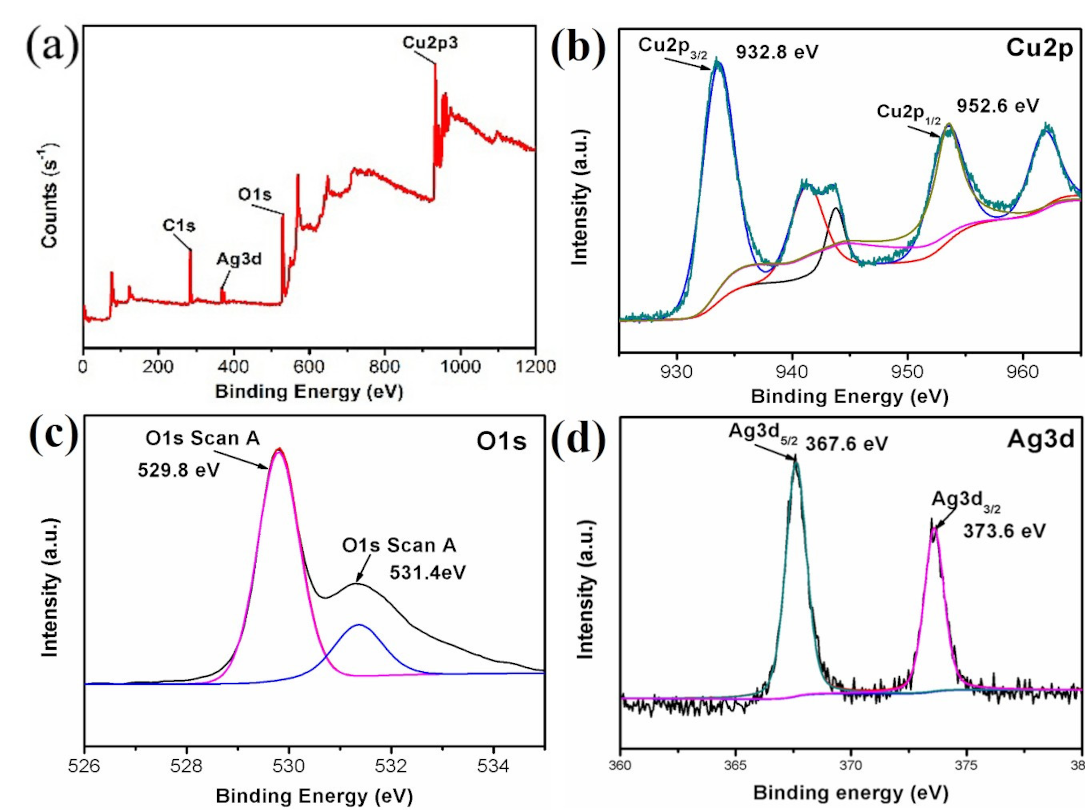
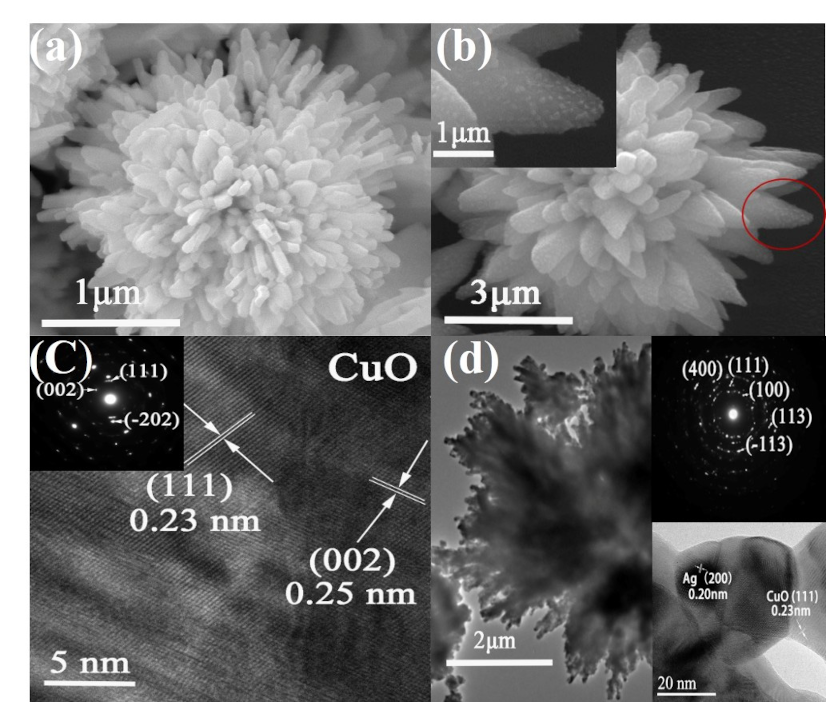
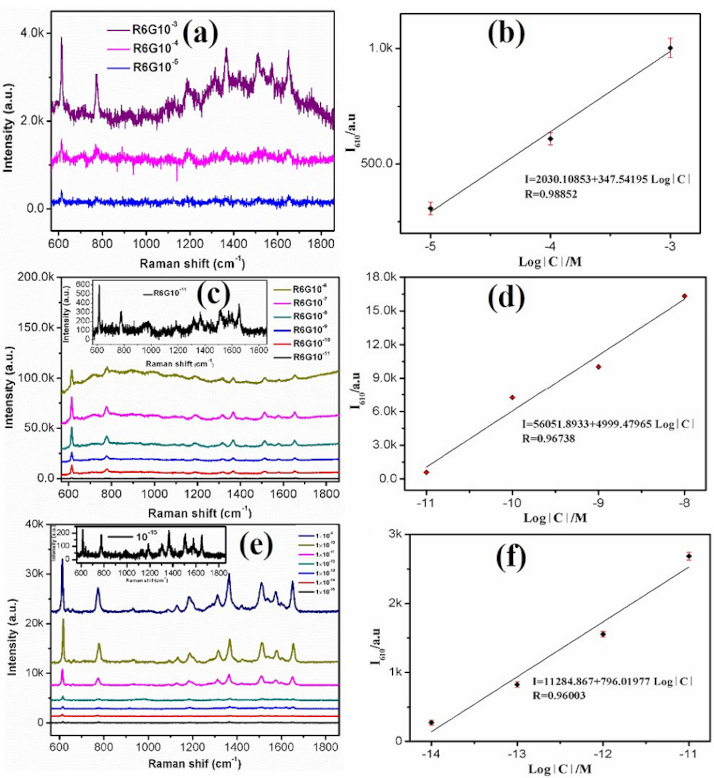
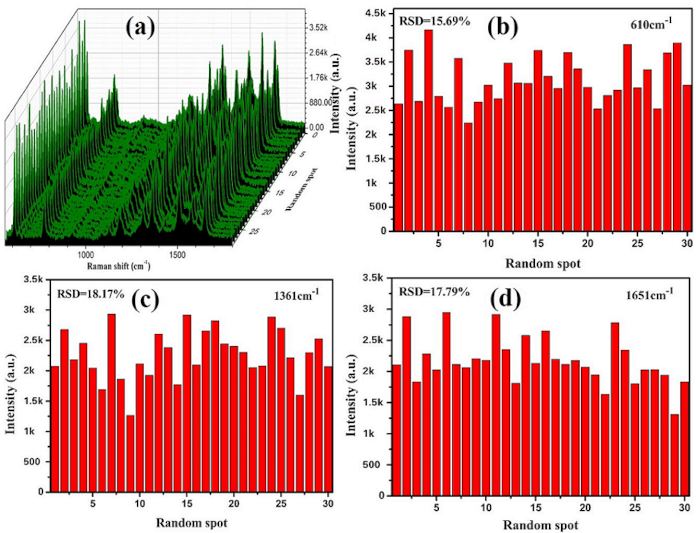
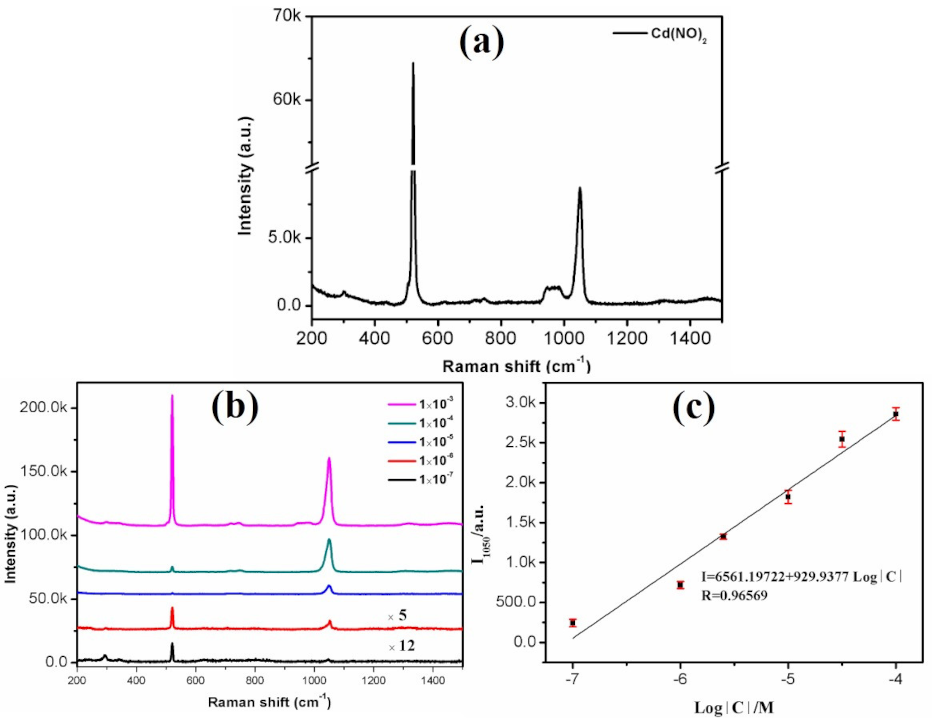
| SERS Substrate | Molecule | LOD(M) | EF | Reference |
|---|---|---|---|---|
| Ag@ZnO | R6G | / | 4.2 × 107 | [15] |
| Ag | R6G | / | / | [29] |
| Ag@CuO | R6G | 1.0 × 10−14 | 3.3 × 109 | [18] |
| Ag-CuO | R6G | 1.0 × 10−9 | 9.46 × 107 | [19] |
| Cu2O/Ag | R6G | 1.13 × 10−13 | 2.7 × 109 | [16] |
| Ag@CuO | R6G | 1.0 × 10−10 | 2.0 × 107 | [17] |
| Au | Cd2+ | / | / | [30] |
| Au-TMT | Cd2+ | 2.9 × 10−6 | / | [1] |
| SiO2@Au | Cd2+ | / | / | [31] |
| Ag@CuO | R6G | 3.58 × 10−16 | 3.99 × 1010 | This work |
| Ag@CuO | Cd2+ | 3.87 × 10−7 | 6.9 × 103 | This work |
© 2020 by the authors. Licensee MDPI, Basel, Switzerland. This article is an open access article distributed under the terms and conditions of the Creative Commons Attribution (CC BY) license (http://creativecommons.org/licenses/by/4.0/).
Share and Cite
Cheng, M.; Li, C.; Li, W.; Liu, Y. Trace Cd2+ Ions Detection on the Flower-Like Ag@CuO Substrate. Nanomaterials 2020, 10, 1664. https://doi.org/10.3390/nano10091664
Cheng M, Li C, Li W, Liu Y. Trace Cd2+ Ions Detection on the Flower-Like Ag@CuO Substrate. Nanomaterials. 2020; 10(9):1664. https://doi.org/10.3390/nano10091664
Chicago/Turabian StyleCheng, Mingming, Chenyan Li, Weijun Li, and Yingkai Liu. 2020. "Trace Cd2+ Ions Detection on the Flower-Like Ag@CuO Substrate" Nanomaterials 10, no. 9: 1664. https://doi.org/10.3390/nano10091664
APA StyleCheng, M., Li, C., Li, W., & Liu, Y. (2020). Trace Cd2+ Ions Detection on the Flower-Like Ag@CuO Substrate. Nanomaterials, 10(9), 1664. https://doi.org/10.3390/nano10091664




